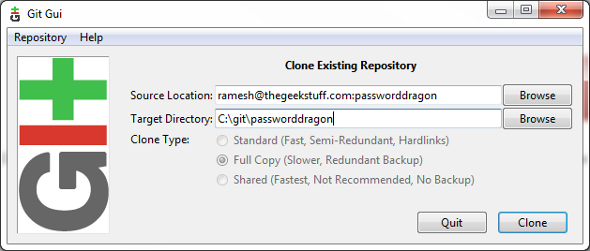
- GIT ADD REMOTE REPOSITORY URL PRO
- GIT ADD REMOTE REPOSITORY URL CODE
- GIT ADD REMOTE REPOSITORY URL LICENSE
- GIT ADD REMOTE REPOSITORY URL SERIES
If you still end up with errors like "Updates were rejected because the remote contains work that you do not have locally", this is normally because that the remote repo is recently created manually. Otherwise you will have to name local branch first by $ git branch -m Īnd then push it to add a new branch called $ git push origin -u Push the changes in your local repository to GitHub if there is a remote branch called master (or main if that's what you're using) $ git push origin master In the Command prompt, add the URL for the remote repository where your local repository will be pushed. $ git commit -m "First commit"Īt the top of your GitHub repository's Quick Setup page, click to copy the remote repository URL. Ĭommit the files that you've staged in your local repository. $ git initĪdd the files in your new local repository. Initialize the local directory as a Git repository. To add the README.Change the current working directory to your local project. You can add an individual file or groups of files to git tracking.
GIT ADD REMOTE REPOSITORY URL PRO
Source: Maxwell Joseph, adapted from Pro Git by Chacon and Straub (2014). Modified files are staged using git add, and following a commit, all files in the staging area are snapshotted and become part of the repository's history, receiving a unique SHA-1 hash identifier. These two commands make up the bulk of many workflows that use git for version control.

You will use the add and commit functions to add and commit changes that you make to git. To keep track of this change to this file, you need to The output from git status indicates that you have modified the file README.md. No changes added to commit (use "git add" and/or "git commit -a") " to discard changes in working directory) Your branch is up-to-date with 'origin/master'. Note that here we are using a bash command - cd (change directory).įor example, on a Unix based system, if you wanted to have your repository in your Documents folder, you change directories as follows: Next, on your local machine, open your bash shell and change your current working directory to the location where you would like to clone your repository. From your repository page on GitHub, click the green button labeled Clone or download, and in the “Clone with HTTPs” section, copy the URL for your repository. Next, clone your newly created repository from GitHub to your local computer. git status, git clone, etc)Ĭlone your repository to your local machine Git specific commands will always started with a call to git (e.g.

Git commands: These are commands that are specific to git and will only be available if you have git installed on your computer. They allow you to navigate around your computer, explore directory structures, create and manipulate files and directories, and more.

There are 2 types of commands that you will useīash commands: These are commands that are native to bash / shell.
GIT ADD REMOTE REPOSITORY URL SERIES
Once you have entered a repository name and made your selection, select Create repository, and you will be taken to your new repository web page.īelow you will learn a series of commands that you can run at the command line in git bash, terminal of whatever bash tool you are using.
GIT ADD REMOTE REPOSITORY URL LICENSE
Similarly, in practice you should choose a license to that people know whether and how they can use your code.gitignore file by selecting one of the languages from the drop down menu, though for this tutorial it will not be necessary. This will take you to a page where you can enter a repository name (this tutorial uses test-repo as the repository name), description, and choose to initialize with a README (a good idea!). In the upper right corner, click the + sign icon, then choose New repository.To begin, sign in to your user account on GitHub.git installed and configured on your computer.
Another pop-up will appear, where you enter the Git Repositorys URL you wish to add, and press < Enter >. When the pop-up appears, enter your Remotes name and press < Enter >.
GIT ADD REMOTE REPOSITORY URL CODE
Modify files in your repository and track changes using commits with git To use the command, press F1 in the Code window, and type: Git: Add Remote.Clone your repository to your local computer.At the end of this activity, you will be able to:


 0 kommentar(er)
0 kommentar(er)
